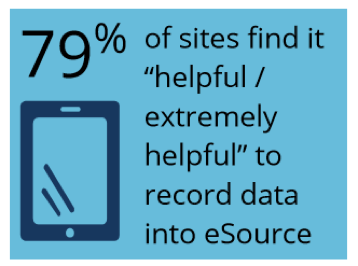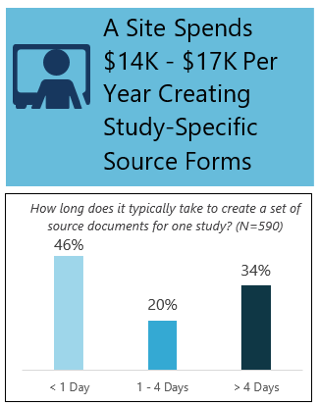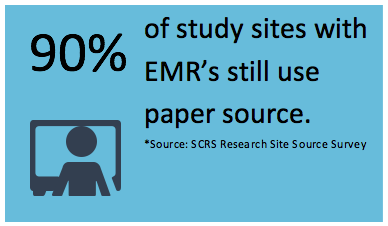Study Sites Indicate eSource Improves Data Quality
The challenges of data quality are a constant factor in clinical trials, especially that of traditional paper source documenting. Joyce Smith of The Medical Research Network speaks about the study’s site perspective on trial data quality.
Data quality challenges continue to impact clinical trials in many forms. However, one of the largest contributors to data quality involves the traditional process of still using paper source documents to collect clinical data. SCRS in collaboration with CenterWatch and Clinical Ink recently released a free whitepaper discussing these challenges in detail. In this interview, we will incorporate the study site’s perspective on data quality by interviewing Joyce Smith, Clinical Country Lead & Research Nurse Manager at The Medical Research Network, a clinical research nursing provider.
Moe Alsumidaie: What do you think about eSource and its impact on data quality?Joyce Smith: I am a big proponent of eSource. It is going to be a great asset for conducting clinical trials. Physicians tend to write things out on paper source forms, which may not record or address the data that’s being collected. With eSource, you know you have to select an option, and the option is cross validated with other questions, which eliminates errors. Additionally, guided functionality helps with making the right choices when it comes to inputting the data into the system. There is no confusion regarding how to fill out the forms. It saves time and effort on everybody's behalf. It is hard to get very clear and concise instructions about which data to record and some sponsors issue more queries after the first two visits. If you have that instruction built into an eSource tablet, you can get the data set that you want. Creating the documents with the built-in queries makes it dummy-pr

oof and you will not have missed data points because of confusion from site staff, ultimately reducing errors and improving data quality. In addition, eSource eliminates the need for staff to re-enter data into EDC after study visits.
The challenge with paper source forms, is if there is a CRF update, we have to go in and update the paper source forms, and we may miss collecting a certain data point. With eSource, if there are updates to the CRF, you receive the updates in the system right away, and know which CRF version you were using with each patient. That is a data quality issue that can be resolved with using eSource.
MA: Describe the current burdens with creating source documents?

JS: Sponsors no longer provide source documents. You have to create your own source documents which creates a burden on the site, especially for the site coordinator. It also increases the time to startup. Unfortunately, you have to work that in with everything else that's going on at the site every day and is very time-consuming. It takes at least two days of work to get it done and to do it right. We use templates but even with that, you have to make sure that the collected data is what the sponsor is asking for in the protocol. Secondly, sometimes the sponsors will request data that is not on the protocol or the schedule. Sometimes, the sponsor wants to go back and add two or three more data points, so you need to go back into the record and re-measure it or add more medical history. So, it would help if we can know upfront what the sponsor wants to do and not keep adding on information to the CRF. That is something that we are not paid for. We get our payment for the visit but not to go back and spend time to get all this new data.
MA: What are the inefficiencies of using paper medical charts?JS: With paper medical charts, there may be multiple volumes of charts that coordinators may not necessarily have access to at the same time; you may think you have all the medical records, but you may be missing some and not even know it. For example, if you are dealing with a patient in oncology, they may have three or four medical charts but you may only have received one or two of them because somebody missed pulling that third one out or the charts are somewhere else and have not been returned yet. While large medical institutions are moving away from paper charts, the majority independent sites still use them. You can share your records with EMR and partner with other hospitals and grant them access to your medical records. This enables staff to see the records without having them sent over to you. If you are pulling records from several offices that use paper, you need all of them to be sent. It takes time for somebody else to respond to your request and this causes significant time delays.
MA: In the wake of EMR adoption at sites, what clinical trial data quality issues do you currently run into when it comes to verifying original source?JS: Our medical practice initially started with the paper medical charts and recently moved to Epic EMR; although we are using EMR thinking that would help us become more efficient, it hasn’t in all areas. EMR is great when it comes to accessing patient information from other hospitals, however, we still get paper charts from other hospitals which sometimes are not very well organized and often are missing information or are outdated. Another common issue I’ve run into on numerous occasions is the integrity of the EMR data from other Medical institutions. Today, patients are seen by doctors at multiple hospitals and sometimes a physician’s staff will inadvertently record incorrect medical information. So, sometimes when it comes to qualifying a patient for a clinical trial it looks like the patient is not eligible for the study, from the information in the EMR but in reality, they are. In order to correct the source, we have to chase somebody down at the other physician’s office to amend the patient’s EMR record. As an example, the EMR may contain a diagnosis

that the patient had a myocardial infraction six-months ago, but the chart indicates that they had a hypertensive incident because the patient did not take their medicine for two weeks. This creates a lot of confusion with both site staff and monitors, and we oftentimes have to write note to the files and have the PI sign off on them.
You’d be surprised on how much incorrect medical information is contained within EMR. There was another instance when one of my research nurses was conducting a study visit with a patient, and medical information in the EMR indicated that the patient had a major surgery, which disqualified the patient from the study. When the patient was asked about the surgery, the patient told us they never had any surgery, and the EMR had to be fixed. Unfortunately, inaccurate information in the EMR is fairly common and can take lot of extra effort and time for the coordinator. If you do not have a coordinator who is very diligent about obtaining accurate data and questioning incorrect source, you end up with data quality issues, and prolonged monitoring visits. The inclusion and exclusion of patients can be dramatically impacted by purely relying on the information in the EMR and the reality is some coordinators may not have the time to chase down other hospital staff to verify or update the information in the EMR.
Moe Alsumidaie, MBA, MSF is Chief Data Scientist at Annex Clinical, and Editorial Advisory Board member for and regular contributor to Applied Clinical Trials.